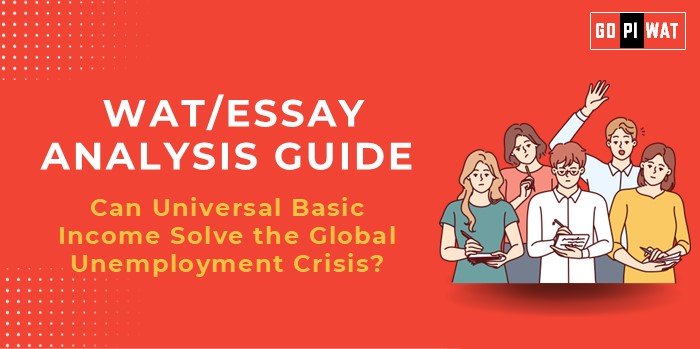📋 WAT/Essay Analysis Guide: Can Universal Basic Income Solve the Global Unemployment Crisis?
🌐 Understanding UBI’s Importance
With rising automation threatening up to 30% of jobs globally by 2030, UBI offers a potential buffer against unemployment and poverty. It provides a fixed income to all citizens unconditionally, ensuring basic financial security. Finland’s and Kenya’s experiments provide valuable insights into its benefits, such as enhanced well-being, and limitations, like fiscal challenges and minimal employment impact.
📝 Effective Planning and Writing
- Time Allocation:
- ⏱️ Planning: 5 minutes
- ✍️ Writing: 20 minutes
- 🔄 Review: 5 minutes
💡 Introduction Techniques for Essays
- Statistical: “As global unemployment stands at 5.1% in 2023, UBI is being explored as a safety net against rising job displacement due to automation.”
- Case-Based: “Finland’s UBI experiment revealed significant improvements in recipients’ well-being, though its employment impact remains debatable.”
📊 Structuring the Essay Body
- 🏆 Achievements:
- ✨ Improved Well-Being: Finland’s UBI experiment (2017–2018) granted €560 monthly to unemployed participants. Recipients reported reduced stress, better health, and higher life satisfaction.
- 💰 Poverty Reduction: Kenya’s UBI trial reduced extreme poverty by 20%, showcasing its potential to address global poverty (8.4% of the population lives below $2.15/day as per World Bank 2023).
- ⚠️ Challenges:
- 💸 Fiscal Constraints: UBI implementation requires significant funding, which may strain government budgets, particularly in developing nations.
- 📉 Employment Impact: Finland’s UBI trial showed no significant employment gains among participants, raising concerns about long-term productivity.
- 🔮 Future Outlook: Hybrid models integrating UBI with skill development programs could mitigate job displacement while ensuring financial security. Policies could combine UBI with targeted initiatives like wage subsidies or conditional welfare schemes.
📄 Concluding Effectively
- Balanced Perspective: “UBI improves well-being but must be complemented with targeted policies to ensure fiscal and economic sustainability.”
- Global Perspective: “While UBI pilots highlight benefits like poverty alleviation, large-scale adoption requires innovative funding and integration with existing systems.”
🔍 Analyzing Successes and Shortcomings
- 🏅 Key Achievements:
- ✨ Enhanced mental and physical health (Finland).
- 💰 Reduction in extreme poverty (Kenya).
- 📋 Simplified welfare systems with minimal administrative overhead.
- ⚠️ Ongoing Challenges:
- 💸 High fiscal demand, making scalability challenging.
- 📉 Lack of significant employment impact, as evidenced by Finland’s results.
- ⚡ Risk of inflation if not funded carefully.
- 🌍 Global Context:
- ✅ Success: Alaska’s Permanent Fund Dividend demonstrates consistent financial benefits for citizens.
- ⚠️ Challenges: Finland’s trial underscores the need to address fiscal and productivity concerns.
🌱 Recommendations for Sustainable Progress
- 🔄 Adopt Hybrid Models: Combine UBI with conditional programs like skill-building and education to promote employability.
- 💸 Progressive Funding Mechanisms: Leverage wealth taxes or carbon taxes to finance UBI sustainably.
- 🌍 Pilot Regional Adaptations: Tailor UBI initiatives to address specific socio-economic contexts.
✍️ Sample Short Essays
- Balanced Perspective: “UBI offers a buffer against automation-driven job losses, but its high costs and employment outcomes demand cautious implementation. Integrating UBI with targeted policies could maximize its benefits while ensuring fiscal sustainability.”
- Solution-Oriented: “A hybrid model integrating UBI with job training can ensure financial security while addressing unemployment challenges. Such an approach balances immediate needs with long-term productivity.”
- Global Comparison: “Experiments in Finland and Kenya showcase UBI’s potential and limitations, suggesting the need for region-specific adaptations. For large-scale success, countries must address fiscal challenges and align UBI with broader economic goals.”


